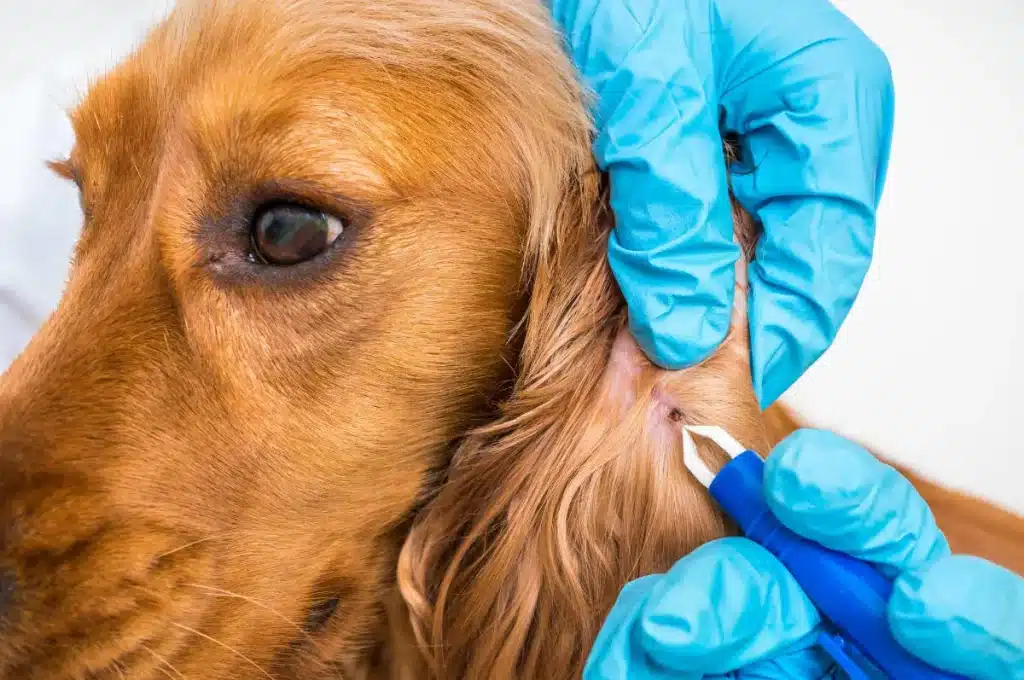Ticks – NOW is the time to act!

As the warmer weather sets in, people are starting to head outdoors for some fun in the sun with their pets – everything from walks, playtimes, adventures in the bush and at dog parks. This is the season to be mindful of the heat and how it effects our pets, but it’s also a season associated with predatory parasites – ticks! These blood sucking critters pose a serious risk to our pets, which makes it even more important to ensure that our pet’s tick treatments are up to date. It’s equally important to remember that ticks affect all animals, even humans, and not just dogs and cats.
Ticks traditionally want a host. You will usually find them clinging to long-grass and shrubs, waiting patiently for an animal to brush past, where they then attach themselves. They are sensitive to heat and when it comes to dogs, the carbon dioxide they exhale, alerts ticks that a potential host is nearby. Ideally dog owners should try and avoid tick habitats during the warmer seasons for example, walking in bush areas, removing compost from backyards, and keeping lawns and shrubs short.
It’s important to be able to identify a tick on your pet. They traditionally have a round body, pincer mouthparts with eight legs, and do often vary in size and colour. When they have not fed, they are small and hard. Once attached to skin, they suck the blood from their host, becoming engorged, at which point they can grow to the size of a small fingernail.
Ticks fall into two main categories: paralysis and brown ticks. The first – paralysis ticks, are dangerous parasites that once attached to the skin of an animal, secrete a toxin directly into the bloodstream, affecting the animal’s nervous system. This toxin causes weakness and paralysis; and if not treated immediately, can ultimately lead to death. This tick is typically found along the east cost of Australia from Cape York to Lakes Entrance Victoria.
The second – brown ticks. These critters don’t cause paralysis, but instead, cause skin irritation and heavy infestations resulting in dermatitis or anaemia from blood loss. This tick is widely found across Australia and is often seen in enclosed spaces like kennels and back yards. It’s important to note, that all ticks can bring diseases, bacteria, and parasites regardless of whether they are brown or paralysis ticks.
Dogs are more often identified with tick paralysis in the early stages, due to their lifestyle and love of the outdoors. An immediate change in their behaviour is indicative by the symptoms they start presenting. Cats are more likely to hide away when affected and therefore are more severe when admitted. Some of the symptoms to look out for are:
-
Loss of coordination in the back legs
-
Including a wobbly look – this can develop into paralysis
-
Change in bark noise and frequency
-
Retching, vomiting or loss of appetite
-
Coughing
-
Laboured or rapid breathing
Being aware of the symptoms of tick paralysis is important for your pet’s safety. If any signs of tick paralysis are seen, or a tick or tick crater is evident, take action and contact your veterinarian immediately.
Regularly checking our dogs and cats for ticks, especially if you’ve been outdoors or on bush walks, is of paramount importance. The essential preventative measure is a thorough search of your pet’s skin and coat at least once a day, even while on prevention medication. If you find a tick on your pet, don’t panic. We recommend where possible to bring them in without delay to see your Northbridge Vet, Randwick Vet or Lindfield Vet to remove any ticks efficiently and safely.
If you’re unable to get to a vet straight away and wish to remove the tick yourself, it’s important to keep your pet calm and steady when using tweezers or commercial products such as Tick Twister or a Tick Lasso. Place the tool near the skin and pull away from the pet’s body, ensuring you remove all the mouthparts. Be careful when squeezing the tick’s body, as this can push more bacteria or toxins into the bloodstream. We advise that you store the removed tick in an airtight container for when you visit us, for proper identification and assessment.
Administering regular tick prevention products as recommended by your veterinarian is crucial to the overall health and wellbeing of your pet. Talk to the team at Vetmed about tick control products that are suitable for your pet. If you are in any doubt when it comes to ticks, get in touch with Vetmed for professional, helpful advice.
